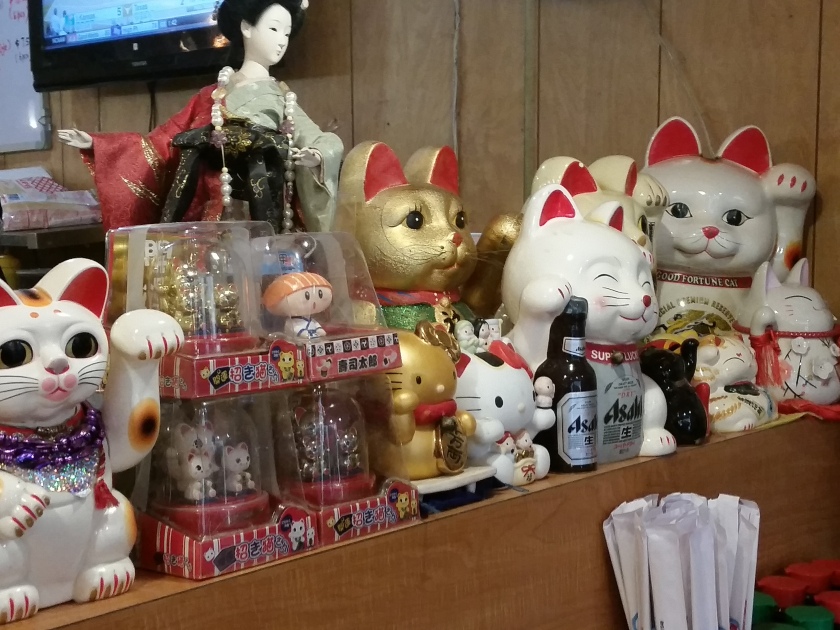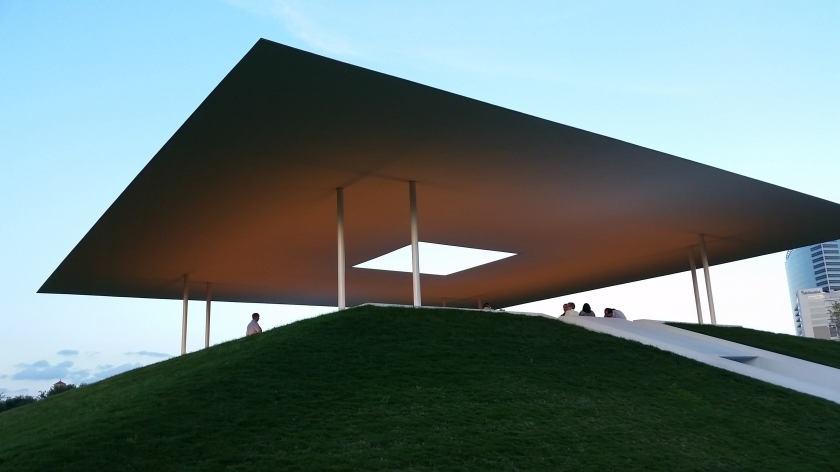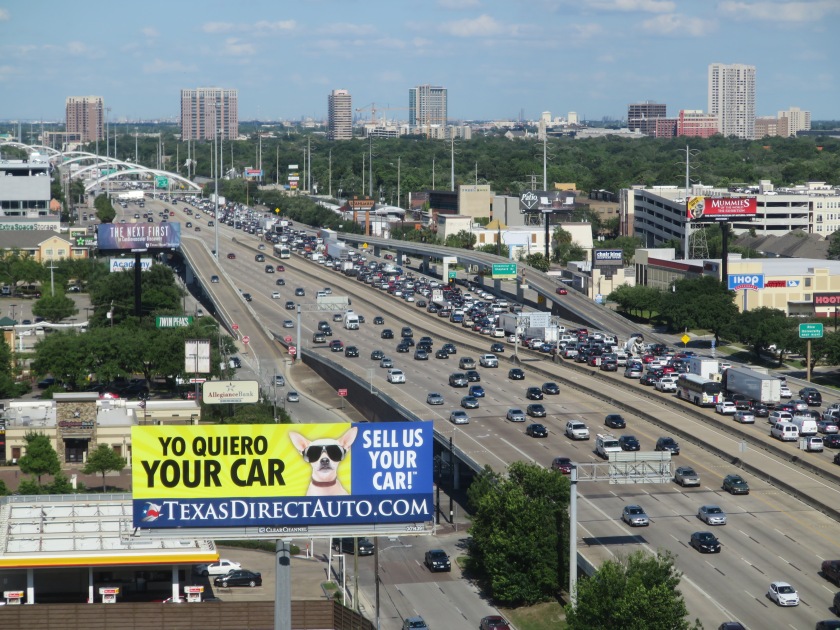food
The Art of Eating Ramen
Food, TexasThere must be an art to eating ramen without splashing, but I don’t know what it is. The small area around my bowl is a target. So is my shirt.
There are tricks to the trade. A fork doesn’t help- stick with chopsticks. Don’t be afraid to wear your napkin to avoid wearing ramen. If they only give you one, ask for more. I need one tucked into my shirt, one on the lap and an extra one to catch any stray splatters.
If you do get hit, there is the straw trick. Place your finger on the top of the drinking straw and capture a little instant cold water to keep the miso broth from settling into your fabric.
Despite the trouble, ramen is usually a good choice in my book. This is the case at Agu, a shop with Hawaiian origins located in Dallas’s Mockingbird Station.
Agu offers several vegetarian options. The one I tried had a satisfying flavor. Often the vegetarian broth is just vegetable broth. It doesn’t have enough flavor for me. If you want to satisfy a vegetarian, you have to get creative. I ordered the Tan Tan Veggie which uses a sesame broth that’s slightly spicy. Among the “vegetables” are wood ear mushrooms. I wasn’t quite sure what wood ear mushrooms were but was happy to see the blackish wood fungus that’s often in hot and sour soup.
 Agedashi tofu is a great choice for an appetizer. It rarely disappoints. The soft tofu is deep-fried and served with green onions and dried seaweed. Don’t let the seaweed scare you away; it’s not something you would notice if you weren’t looking for it.
Agedashi tofu is a great choice for an appetizer. It rarely disappoints. The soft tofu is deep-fried and served with green onions and dried seaweed. Don’t let the seaweed scare you away; it’s not something you would notice if you weren’t looking for it.
Our server told us about the origins of the restaurant in Hawaii where there are a handful of locations. To expand further, they looked to Texas because the West Coast was saturated. They first found Houston where Agu has almost as many locations.
Despite new shops, the ramen scene is still pretty wide-open in Dallas. If you’re looking for good noodles and not a pseudo-Japanese experience, the scene here is really open. I am one of those people who think the idea of authentic food is a misnomer. People move and the food changes and different ingredients become available. And so you can see from the website Agu has a Hawaii menu and a Texas menu. Good food isn’t usually trying to be something, it reflects the skill and creativity of the chef, as well as the place.
It may be “authentic,” but I wouldn’t know it. I just know it’s good.
Agu is located in Mockingbird Station near the bike entrance from the trail- toward the end of the complex toward Mockingbird Lane.
Houston Holds its Own
Featured, Food, TravelThe cashier at a CD store in Houston was coughing and sneezing. Are you ok? Someone asked. “Just my allergies,” he replied. “It isn’t the first time I said it: people don’t move to Houston for their health.”
Houston is a city some people, including those in much of Texas, love to hate. It just isn’t an attractive city and the weather is often unbearable. Physically, it’s a mishmash of commercial and residential, a few blocks of swanky shopping districts and then vacant lots. New urban high-rises and low-density retail development seeming to be at odds. Disorder, even ugliness reigns supreme.
So? What’s my point?
I live in Dallas. Here, it’s almost a prerequisite that I don’t like Houston. But I do like Houston. It’s also hard to find a Houstonian who doesn’t like Houston. Insiders know what outsiders can’t instantly see. In Houston, there is a lot to like.

Where weather and charm fails, a happy stomach helps. I can’t imagine many cities in Texas, and only a handful in the U.S. can compete with the food in Houston. I’m not talking about those often pretentious, trendy restaurants opened by celebrity chefs where you go to be seen. Dallas has plenty of those places. I am talking about the authentic food options that exist only because there is a large enough ethnic population, and those familiar with it, to support it. Or the food combinations that come from a clash of cultures. In terms of large metros, Houston ranks behind San Jose and New York while tieing with Oakland, CA in terms of ethnic and cultural diversity. The largest ethnic group here doesn’t make up more than 40 percent.
If you haven’t seen Anthony Bourdain’s Parts Unknown show on Houston, it’s a must see to get a pretty good idea about the food options here. I would also suggest it for anyone with the opinion that immigration is a bad thing. What you find in Houston can only be found in America and is in every sense of the word American.
Great food and plenty of it means Houstonians aren’t the slimmest bunch (though Dallas is fatter), in part because they drive around a lot. In many places, Houston isn’t very walkable, and the transit doesn’t seem to be anything to write home about (even to Dallas), but the parks are something for most Texan’s to envy. Memorial Park is enormous and very well used, at least on a Sunday in February. The more formal and manicured Hermann Park in the museum district is also something more familiar to residents of the older cities, primarily in the Northeast. What makes a good “park” to me is that it’s not just a loop or a linear trail, it has four sides and allows for the opportunity to get “lost.” From what I have seen, they are well-used despite the heat.
Houston is culturally rich. I can’t imagine lacking for art openings or museum shows. Museum of Fine Arts Houston is major. At any given time there are a half dozen exhibits. Plus Houston has the Menil, the Art League and other art destinations. It also helps to have a major university inside city limits. Rice University is home to the Asia Society and the newly-opened Moody Center for the Arts. Plus who can tire of taking in the sunset at Skyspace.

As far as the physical city, you may have heard Houston doesn’t have zoning. As you can imagine, that brings about a different sort of place. While there may be blocks here and there with missing sidewalks, the free-range development approach allows for more of a mix of retail and residential. It also contributes to lower construction costs, which helps with affordability. Houston is one of the most affordable big cities (although don’t forget to account for the cost of increased travel times in a spread-out region, necessity of car ownership, etc).
On my trips to Houston, I have been on the lookout for “new urban” mixed-use areas comparable to West Village in Uptown Dallas. While Houston’s MidTown area is coming along, I haven’t found anything quite like West Village, nothing “built-right” from the ground up. Yet I am unsure that even if executed flawlessly the walkable mixed-use areas can compete with the mix of old and new despite the variations in density. Which is better, pretty and perfect, or real?

Houston, despite its flaws, is a culturally-rich place that is only discovered with time. Don’t let the weather scare you away either, most residents would say it’s a good place to live. After a few trips, I discovered it is a really good place to visit. In terms of people, places, and experiences, I’ve found a real city, and have yet to experience a moment of visual or culinary boredom.
Not Time to Eat Yet, New Foodie Market Coming to Dallas
Food, TexasIt finally looked like what’s being touted as a new retail concept in Dallas had opened its doors. I saw a Twitter post announcing the arrival of Uptown Urban Market, and Google concurred with a Open Now message. The Internet doesn’t always mirror life, however. I walked over to find it closed. The website doesn’t give an opening day and seems incomplete displaying notes about what photos to add.
 It would appear to be opening before long. While the “new” concept seems to be basically a food court, having a food court in this part of Dallas is new. It’s not a sit-down restaurant, probably will rely on foot traffic, and probably will not feature the Dallas staple of valet parking.
It would appear to be opening before long. While the “new” concept seems to be basically a food court, having a food court in this part of Dallas is new. It’s not a sit-down restaurant, probably will rely on foot traffic, and probably will not feature the Dallas staple of valet parking.
I do look forward to my first visit. A list of vendors is available here.
Five Things You can Do to Make Life More Interesting
LifestyleTired of Facebook? Does a trip to the discount store get you down? Do you feel on the usual side? Do visitors to your home have nothing that screams “you” to notice. You don’t have to settle for all the ordinary things you can click and buy now. Check out these suggestions for changes you can make now to be engaged and make life more interesting.
Things You Can Do To Make Life More Interesting:
1. Find and buy art
You’ve been to a museum, right? Lots of interesting people there. Lots of art too. Guess what, you don’t have to be on the board of a large corporation to buy art. Art is being made by lots of people right around you, and they would benefit from your support. Buying art means engaging with lots of interesting people at galleries, openings and studio tours. There’s no reason to have bare walls- or worse, stuff from Ikea hanging there. Get out there! be confident. Buy what you like. Don’t yet your walls scream “I’m boring.”
2. Switch from files to records and compact discs
You do know its illegal to “share” music files right? Well its still ok to lend a friend a compact disc. Music downloads from the computer leave behind the whole culture of records and record stores. The culture of local music is also often centered around these stores. Plus records and cds come with pictures and lyrics and you won’t lose them if your computer crashes. Most cds and even vinyl records now come with downloads for your portable devices. And you can sell the ones you’re tired of!
3. Replace department store furniture with antiques
Older things, especially those made by hand, give you a lot more to talk about. If they are family pieces, they bring back certain memories. Even if you don’t know much about them, someone else does and that learning venture can be pretty fun. There’s also the story of how you came upon an item, whether it be a fancy show, dusty antique store, roadside flea market or amazing estate sale. There’s just not much to say if you chose it from the Pottery Barn catalog. It’s also a green thing to do, especially if you buy it locally.
4. Add vintage accessories
Dressing in period vintage isn’t for everyone. In fact you may be pegged as downright odd if you don’t pull it off just right. There’s nothing particularly wrong with being odd, but it’s easy to come off as interesting when you accent your outfit with vintage items. This can be anything from a scarf, hat, purse, jewelry belt, belt buckle or even glasses. Yes, you can buy an old pair of glasses and have prescription lenses inserted. The cost savings will allow room for a second or third pair. Think sunglasses.
5. Shop locally, eat locally
I’ve been getting more and more annoyed lately with corporate slogans at stores and restaurants. Are you really glad I am here today? Do you really want me to be well? You can avoid all that by seeking out local stores, and a great place to start is a farmer’s market. Imagine being able to ask questions about vegetables and get answers from the people who grew them! Plus there are often entrepreneurs selling sauces, wine and other items. Each one represents someone’s passion and they are all too happy to share that passion. And you know what? It just may rub off on you.
It Has Come to Soylent
Food, NewsLogI was fascinated after reading an article in The New Yorker, so I ordered Soylent. No, its probably not The End of Food. While Soylent could replace food entirely, its creators say its more likely that it will replace those quick, bad meals with a complete and filling nutrition drink. You’ve heard the phrase some people eat to live, and some people live to eat. Soylent was created by some techies in California who thought eating was taking up too much time and money. It seems to run about $4 a meal. Does it work? I don’t know.
On Gluten
Food, NewsLogA funny clip went around on Facebook yesterday in which Jimmy Kimmel asks people who avoid eating gluten what it is. No one seems to know. I shared the link on Facebook, and it seems the hubbub is chalked up either to marketing, or companies following consumers into the fad. Gluten of course is a real problem for those who have something called celiac disease, and I did read references on the web to something about the way the wheat has been genetically modified that doesn’t give with our paleo digestive systems. I also read however that people who try to eliminate gluten, miss out of fiber and a lot of vitamins. Yes, yes, it’s not only about what you eat, its about what you would be eating if you didn’t eat this or that.
We learn to trust certain sources to cut to an answer we can live with, however, and a search for Forks Over Knives and gluten brought up a page with tremendous insight and lots of research to back it up. It turns out avoiding gluten can lead to lots more animal product consumption, and we know without a doubt where that leads. I thought I’d share.
The Smoke and Mirrors Behind Wheat Belly and Grain Brain
Steady Decline Continues In Land Devoted To Farming
Food, NewsLogThe 2012 Census of Agriculture released today shows a nationwide drop in land devoted to agricultural production from 922 million acres in 2007 to less than 915 million acres. This reduction continues a downward trend that has resulted in a 72 million acre decrease of land in agriculture since 1982.
States with the largest percentage declines in land devoted to agriculture were: Kentucky- 6.7 percent, Alaska- 5.4 percent, Georgia- 5.2 percent, Mississippi- 4.6 percent and Wisconsin- 4.1 percent.Increases in land in farms were reported in 19 states. The largest percentage gains were in: Maine- 7.9 percent, Connecticut- 7.6 percent, Florida- 3.4 percent, Rhode Island- 2.6 percent, and Virginia- 2.4 percent.
Paving the Planet: Cars and Crops Compete for Land
Food(by Lester R. Brown) As the new century begins, the competition between cars and crops is intensifying. Until today, the paving over of cropland has occurred largely in industrial countries, home to four fifths of the world’s 520 million automobiles. But now, more and more farmland is being sacrificed in developing countries with hungry populations, calling into question the future role of the car.
Millions of hectares of cropland in the industrial world have been paved over for roads and parking lots. Each U.S. car, for example, requires on average 0.07 hectares (0.18 acres) of paved land for roads and parking space. For every five cars added to the U.S. fleet, an area the size of a football field is covered with asphalt.
More often than not, cropland is paved simply because the flat, well-drained soils that are well suited for farming are also ideal for building roads. Once paved, land is not easily reclaimed. As environmentalist Rupert Cutler once noted, “Asphalt is the land’s last crop.”
The Last Crop
The United States, with its 214 million motor vehicles, has paved 6.3 million kilometers (3.9 million miles) of roads, enough to circle the Earth at the equator 157 times. In addition to roads, cars require parking space. Imagine a parking lot for 214 million cars and trucks. If that is too difficult, try visualizing a parking lot for 1,000 cars and then imagine what 214,000 of these would look like. However we visualize it, the U.S. area devoted to roads and parking lots covers an estimated 16 million hectares (61,000 square miles), an expanse approaching the size of the 21 million hectares that U.S. farmers planted in wheat last year. But this paving of land in industrial countries is slowing as countries approach automobile saturation. In the United States, there are three vehicles for every four people. In Western Europe and Japan, there is typically one for every two people.
In developing countries, however, where automobile fleets are still small and where cropland is in short supply, the paving is just getting underway. More and more of the 11 million cars added annually to the world’s vehicle fleet of 520 million are found in the developing world. This means that the war between cars and crops is being waged over wheat fields and rice paddies in countries where hunger is common. The outcome of this conflict in China and India, two countries that together contain 38 percent of the world’s people, will affect food security everywhere.
Car-centered industrial societies that are densely populated, such as Germany, the United Kingdom, and Japan, have paved an average of 0.02 hectares per vehicle. And they have lost some of their most productive cropland in the process. Similarly, China and India also face acute pressure on their cropland base from industrialization. Although China covers roughly the same area as the United States, its 1.3 billion people are concentrated in just one third of the country–a thousand-mile strip on the eastern and southern coast where the cropland is located.
If China were one day to achieve the Japanese automobile ownership rate of one car for every two people, it would have a fleet of 640 million, compared with only 13 million today. While the idea of such an enormous fleet may seem farfetched, we need only remind ourselves that China has already overtaken the United States in steel production, fertilizer use, and red meat production. It is a huge economy and, since 1980, is also the world’s fastest growingeconomy.
Assuming 0.02 hectares of paved land per vehicle in China, as in Europe and Japan, a fleet of 640 million cars would require paving nearly 13 million hectares of land, most of which would likely be cropland. This figure is over one half of China’s 23 million hectares of rice land, part of which it double crops to produce 135 million tons of rice, the principal food staple. When farmers in southern China lose a hectare of double-cropped riceland to the automobile, their rice production takes a double hit. Even one car for every four people, half the Japanese ownership rate, would consume a substantial area of cropland.
The situation in India is similar. While India is geographically only a third the size of China, it too has more than 1 billion people, and it now has 8 million motor vehicles. Its fast-growing villages and cities are already encroaching on its cropland. Add to this the land paved for the automobile, and India, too, will be facing a heavy loss of cropland. A country projected to add 515 million more people by 2050 cannot afford to cover valuable cropland with asphalt for roads and parking lots.
Driven to Starvation
There is not enough land in China, India, and other densely populated countries like Indonesia, Bangladesh, Pakistan, Iran, Egypt, and Mexico to support automobile-centered transportation systems and to feed their people. The competition between cars and crops for land is becoming a competition between the rich and the poor, between those who can afford automobiles and those who struggle to buy enough food.
Governments, such as that in the United States, that subsidize an automobile infrastructure with revenues collected from the entire population are, in effect, collecting money from the poor to support the cars of the wealthy. In subsidizing the development of an auto-centered transport system, governments are also inevitably subsidizing the paving of cropland. If, as now seems likely, automobile ownership never goes beyond the affluent minority in developing countries, this becomes an ongoing and largely invisible transfer of income from the poor to the rich. And in Western economies, even the driving poor, who cannot afford to motor as much as the rich, and who are forced to devote larger proportions of their income to maintaining a car and to supporting automobile infrastructure costs because of the lack of public transport alternatives, subsidize the long commutes and weekend jaunts of the well-off.
In a land-hungry world, the time has come to reassess the future of the automobile, to design transportation systems that provide mobility for entire populations, not just affluent minorities, and that do this without threatening food security. When Beijing announced in 1994 that it planned to make the auto industry one of the growth sectors for the next few decades, a group of eminent scientists–many of them members of the National Academy of Sciences–produced a white paper challenging this decision. They identified several reasons why China should not develop a car-centered transport system, but the first was that the country did not have enough cropland both to feed its people and to provide land for the automobile.
The team of scientists recommended that instead of building an automobile infrastructure of roads and parking lots, China should concentrate on developing state-of-the-art light rail systems augmented by buses and bicycles. This would not only provide mobility for far more people than a congested auto-centered system, but it would also protect cropland.
There are many reasons to question the goal of building automobile-centered transportation systems everywhere, including climate change, air pollution, urban fragmentation, and traffic congestion. But the loss of cropland alone is sufficient. Nearly all of the 3 billion people to be added to the current world population of 6 billion by mid-century will be born in developing countries where there is not enough land to feed everyone as it is, let alone feed people and accommodate the automobile. Future food security now depends on restructuring transportation budgets: investing less in highway infrastructure and more in rail and bicycle infrastructure.
Lester Brown
For data and additional information, go to: www.worldwatch.org/alerts/indexia.html, or contact Reah Janise Kauffman at:
Worldwatch Institute
1776 Massachusetts Ave., NW
Washington, DC 20036
202 452-1992, ext. 514 email: rjkauffman@worldwatch.org






